Some 47,000 runners competed in the 26.2-mile ING New York City Marathon on Nov. 6 — and family, volunteers and a even a few furry friends greeted them along the way. Here are a few stories from the route:
Mile 7: The Art of the Water Handoff
PARK SLOPE – Handing out water has always been a staple of the marathon. But few appreciate the subtle art form of giving a thirsty runner relief without spilling a drop.
Steven E. Shovers, who has volunteered to pass out water to marathoners for the past 16 years, demonstrated his technique, hooking his finger along the rim of the cup with practiced ease.
“As they catch on, I kind of let go,” the Park Slope resident said. “The secret is to fill it up about halfway so they can drink it instead of having it go all over them.”
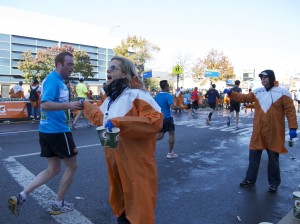
CUP RUNNETH OVER: There's an art to handing out water on the marathon route. (Photo by Kate Trafecante)
Shovers and about 60 other volunteers, all wearing orange-and-white ponchos, manned the fluid station just past the seven-mile marker on Fourth Avenue – one of 23 water spots along the route.
Veteran volunteers shared tips with novices. Flat palms are important, the veterans stressed, as well as a long reach.
But even with practice, the task proved difficult.
“They warn you, but once you see the amount of people that come by, it’s unbelievable,” said Angel Gavida, a volunteer from Central Falls, RI. “I was definitely trying to make sure I didn’t spill it on them.”
For many volunteers, like Alicia Diaz, the reverse was true.
“I had a streak of Gatorade going all the way down my jeans,” she said.
– Kate Trafecante
Mile 9: Four-legged Spectators
CLINTON HILL – Along Lafayette Avenue, marathoners ran past hundreds of cheering spectators – many of whom held onto barking dogs that seemed a little confused by the spectacle.
Damaris Colhoun, 31, a freelance writer brought Thelonious, her 2-year-old Tipperary terrier to watch.
“I thought it was a real exciting alternative to taking a walk to the park,” Colhoun said. “Although I feel like they’re a little bit more like, ‘Why are we here?’”
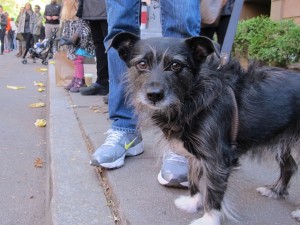
BARKING BRIGADE: Rabito, a rescue dog from Spain, helped cheer the runners. (Photo by Carla Astudillo)
Thelonious, and his Norwich terrier friend Basil, who belonged to Colhoun’s friend, Amy Vokey, seemed to fare better than Greg, a half-poodle, half-terrier who barked at runners and scampered around the sidelines.
“It’s a nightmare,” said his owner Dale Hrabi, 48, as the band from Bishop Loughlin Memorial High School played the theme from Rocky nearby. “He’s just way over stimulated.”
Some dogs, like Rabito, a Border collie rescue dog from Spain, seemed to motivate the runners. Runners smiled at Rabito, as he barked and wagged his tail.
– Carla Astudillo
Mile 17: A Marathon Veteran Watches
UPPER EAST SIDE – As a seven-time marathoner, Shanna Hennig knows how important the cheers are.
Hennig, 33, who has run in two New York City marathons and five in other cities, stood on a metal fence along First Avenue with her friend, one-time marathoner Candyce Hedlund, 29. Their purpose: to cheer on their friend Marc Middlekauff and Hedlund’s sister, Kendra.
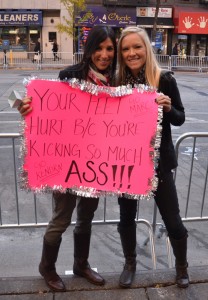
NEW ROLES: Shanna Hennig (left) and Candyce Hedlund have gone from running marathons to cheering from the sidelines. (Photo by Dobrina Zhekova)
“New York is my favorite race out of the seven that I have done. There are people from the beginning till the end cheering you. It’s the only race like it,” said Hennig, an art appraiser from Denver and first-time marathon spectator.
Hennig and her friend chose to wait at the spot where some runners start to feel they are about to hit “the wall.” For most runners, that moment comes later, around the 20th mile, when fatigue sets in due to the lack of glycogen.
“Your body is about to hit its max, and then you hear the screams, the cheers and the support of the crowd, that pushes you through and you know once you get through this part you can finish it,” she said.
On Sunday, she wanted to make sure she was on the sidelines to help her friends get past that critical point. She checked her iPhone, realized they were fast approaching and started cheering excitedly. Middlekauff acknowledged the support: He waved, winked and kept running.
– Dobrina Zhekova
Mile 19: GPS for Runners
HARLEM – Just 15 years ago, runners could only monitor their start and finish times, and the only way spectators could make sure to catch their loved ones in the race was good guesswork.
Now, runners wear chips on their shoes and can get mile-by-mile breakdowns of their time from start to finish. Spectators can track individual runners with real-time results on their phones or via the web.
“It used to be a bar code scanning system where we’d pull a tag physically off the runners when they finished,” said Fred Torres, a longtime employee of Elite Racing Systems, a company that handles the timing and tracking technology for the marathon.
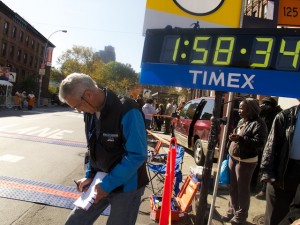
KEEPING TABS: Fred Torres helped track lead female runners using the latest technology. (Photo by Kimie Bunyasaranand)
Torres, who manages the checkpoint at Marcus Garvey Park in Harlem, explained that 74 tracking systems kept information on runners this year, ten more than in 2010.
“I have crews on Mile 19, 20, 21 and this one,” he said. “You have all this information going to the server and people managing the controls, so if anything goes wrong, I can fix it right there on the spot.”
Runners can even register their medical conditions in advance, Torres noted. If anything happens, staff in the medical tents can scan a chip and know exactly what to do – or what not to do.
“The technology is definitely getting better,” Torres said.
– Kimie Bunyasaranand
Mile 20: Massages on the Fly
SOUTH BRONX – Nereida Munoz stood on the edge of Alexander Avenue in the Bronx, facing the onrush of marathoners. She waved a baton in the air and yelled, “Stick! Stick!”
Some runners’ faces lit up when they saw her. They half ran, half hobbled, toward the sidelines where Munoz and several other volunteers offered free massages with a baton-like tool known as “The Stick.”
“It’s so much fun,” said Munoz, as she rolled The Stick over one runner’s sore shoulders. “But by the time we leave, we’re exhausted.”
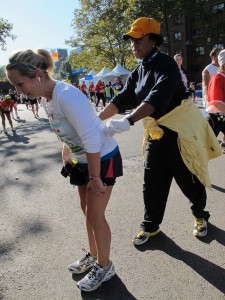
STICK-LER: Volunteer Ova September massages the sore back of one runner, using The Stick. (Photo by Lindsay Armstrong)
The volunteers, members of the New York Walkers Club, started giving massages five years ago at the end of the 20th mile mark, a grueling part of the race where many runners experience serious pain.
Lon Wilson, the club’s director, came up with the idea after watching marathoners struggle with muscle cramps. He wanted all participants to receive the same care that the top runners do – and an estimated 500 took advantage.
First-time marathoner Jeff Tremble stopped because his legs started to cramp.
“I can finish strong now,” Tremble said.
Elizabeth Bouguard, another first timer, asked volunteer Anita Milles to roll The Stick over her tight hamstring.
“This is amazing,” Bougard cooed. “This is life-changing.”
Milles, a first-time volunteer, said she felt she made a difference for some racers.
“They all want to make it to the finish line,” Milles said. “A little alleviation of pain helps so much. A little TLC.”
– Lindsay Armstrong



